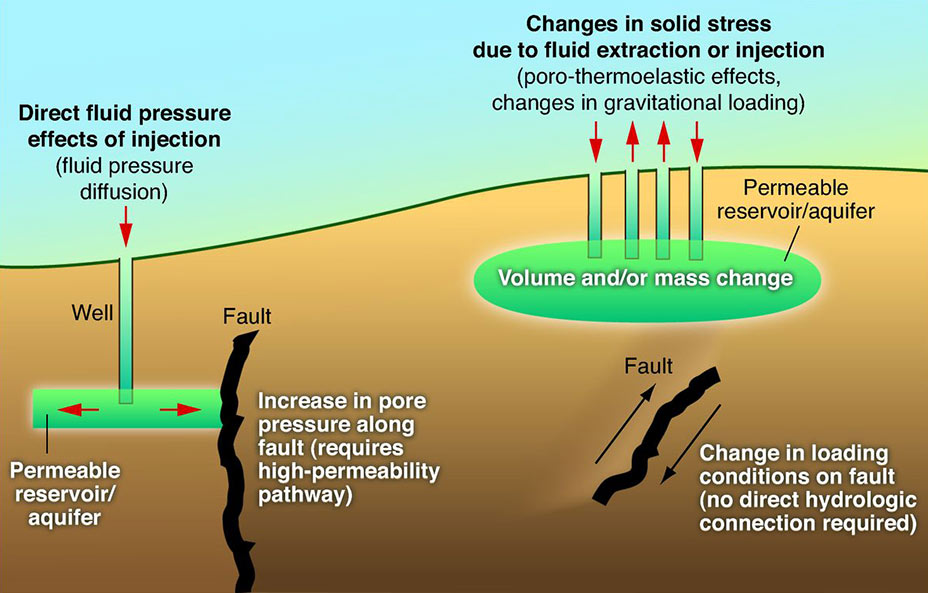|
Self-organized Criticality Control
In applied physics, the concept of controlling self-organized criticality refers to the control of processes by which a self-organized system dissipates energy. The objective of the control is to reduce the probability of occurrence of and size of energy dissipation bursts, often called ''avalanches'', of self-organized systems. Dissipation of energy in a self-organized critical system into a lower energy state can be costly for society, since it depends on avalanches of all sizes usually following a kind of power law distribution and large avalanches can be damaging and disruptive. Schemes Several strategies have been proposed to deal with the issue of controlling self-organized criticality: #''The design of controlled avalanches.'' Daniel O. Cajueiro and Roberto F. S. Andrade show that if well-formulated small and medium avalanches are exogenously triggered in the system, the energy of the system is released in a way that large avalanches are rarer. #'' The modification of ... [...More Info...] [...Related Items...] OR: [Wikipedia] [Google] [Baidu] |
Applied Physics
Applied physics is the application of physics to solve scientific or engineering problems. It is usually considered to be a bridge or a connection between physics and engineering. "Applied" is distinguished from "pure" by a subtle combination of factors, such as the motivation and attitude of researchers and the nature of the relationship to the technology or science that may be affected by the work. Applied physics is rooted in the fundamental truths and basic concepts of the physical sciences, but is concerned with the utilization of scientific principles in practical devices and systems, and in the application of physics in other areas of science and high technology. Examples of research and development areas * Accelerator physics * Acoustics *Atmospheric physics *Biophysics * Brain–computer interfacing *Chemical physics * Differentiable programming **Artificial intelligence **Scientific computing *Engineering physics **Chemical engineering ** Electrical engineering *** ... [...More Info...] [...Related Items...] OR: [Wikipedia] [Google] [Baidu] |
Power Outage
A power outage (also called a powercut, a power out, a power failure, a power blackout, a power loss, or a blackout) is the loss of the electrical power network supply to an end user. There are many causes of power failures in an electricity network. Examples of these causes include faults at power stations, damage to electric transmission lines, substations or other parts of the distribution system, a short circuit, cascading failure, fuse or circuit breaker operation. Power failures are particularly critical at sites where the environment and public safety are at risk. Institutions such as hospitals, sewage treatment plants, and mines will usually have backup power sources such as standby generators, which will automatically start up when electrical power is lost. Other critical systems, such as telecommunication, are also required to have emergency power. The battery room of a telephone exchange usually has arrays of lead–acid batteries for backup and also ... [...More Info...] [...Related Items...] OR: [Wikipedia] [Google] [Baidu] |
Chaos Theory
Chaos theory is an interdisciplinary area of scientific study and branch of mathematics focused on underlying patterns and deterministic laws of dynamical systems that are highly sensitive to initial conditions, and were once thought to have completely random states of disorder and irregularities. Chaos theory states that within the apparent randomness of chaotic complex systems, there are underlying patterns, interconnection, constant feedback loops, repetition, self-similarity, fractals, and self-organization. The butterfly effect, an underlying principle of chaos, describes how a small change in one state of a deterministic nonlinear system can result in large differences in a later state (meaning that there is sensitive dependence on initial conditions). A metaphor for this behavior is that a butterfly flapping its wings in Brazil can cause a tornado in Texas. Small differences in initial conditions, such as those due to errors in measurements or due to rounding error ... [...More Info...] [...Related Items...] OR: [Wikipedia] [Google] [Baidu] |
Control Theory
Control theory is a field of mathematics that deals with the control of dynamical systems in engineered processes and machines. The objective is to develop a model or algorithm governing the application of system inputs to drive the system to a desired state, while minimizing any ''delay'', ''overshoot'', or ''steady-state error'' and ensuring a level of control stability; often with the aim to achieve a degree of optimality. To do this, a controller with the requisite corrective behavior is required. This controller monitors the controlled process variable (PV), and compares it with the reference or set point (SP). The difference between actual and desired value of the process variable, called the ''error'' signal, or SP-PV error, is applied as feedback to generate a control action to bring the controlled process variable to the same value as the set point. Other aspects which are also studied are controllability and observability. Control theory is used in control sys ... [...More Info...] [...Related Items...] OR: [Wikipedia] [Google] [Baidu] |
Self-organized Criticality
Self-organized criticality (SOC) is a property of dynamical systems that have a critical point as an attractor. Their macroscopic behavior thus displays the spatial or temporal scale-invariance characteristic of the critical point of a phase transition, but without the need to tune control parameters to a precise value, because the system, effectively, tunes itself as it evolves towards criticality. The concept was put forward by Per Bak, Chao Tang and Kurt Wiesenfeld ("BTW") in a paper Papercore summaryhttp://papercore.org/Bak1987 published in 1987 in '' Physical Review Letters'', and is considered to be one of the mechanisms by which complexity arises in nature. Its concepts have been applied across fields as diverse as geophysics, physical cosmology, evolutionary biology and ecology, bio-inspired computing and optimization (mathematics), economics, quantum gravity, sociology, solar physics, plasma physics, neurobiology and others. SOC is typically observed in slowl ... [...More Info...] [...Related Items...] OR: [Wikipedia] [Google] [Baidu] |
Complex Network
In the context of network theory, a complex network is a graph (network) with non-trivial topological features—features that do not occur in simple networks such as lattices or random graphs but often occur in networks representing real systems. The study of complex networks is a young and active area of scientific research (since 2000) inspired largely by empirical findings of real-world networks such as computer networks, biological networks, technological networks, brain networks, climate networks and social networks. Definition Most social, biological, and technological networks display substantial non-trivial topological features, with patterns of connection between their elements that are neither purely regular nor purely random. Such features include a heavy tail in the degree distribution, a high clustering coefficient, assortativity or disassortativity among vertices, community structure, and hierarchical structure. In the case of directed networks these fea ... [...More Info...] [...Related Items...] OR: [Wikipedia] [Google] [Baidu] |
Abelian Sandpile Model
The Abelian sandpile model (ASM) is the more popular name of the original Bak–Tang–Wiesenfeld model (BTW). BTW model was the first discovered example of a dynamical system displaying self-organized criticality. It was introduced by Per Bak, Chao Tang and Kurt Wiesenfeld in a 1987 paper. Three years later Deepak Dhar discovered that the BTW sandpile model indeed follows the abelian dynamics and therefore referred to this model as the Abelian sandpile model. The model is a cellular automaton. In its original formulation, each site on a finite grid has an associated value that corresponds to the slope of the pile. This slope builds up as "grains of sand" (or "chips") are randomly placed onto the pile, until the slope exceeds a specific threshold value at which time that site collapses transferring sand into the adjacent sites, increasing their slope. Bak, Tang, and Wiesenfeld considered process of successive random placement of sand grains on the grid; each such place ... [...More Info...] [...Related Items...] OR: [Wikipedia] [Google] [Baidu] |
Induced Seismicity
Induced seismicity is typically minor earthquakes and tremors that are caused by human activity that alters the stresses and strains on Earth's crust. Most induced seismicity is of a low magnitude. A few sites regularly have larger quakes, such as The Geysers geothermal plant in California which averaged two M4 events and 15 M3 events every year from 2004 to 2009. The Human-Induced Earthquake Database (''HiQuake'') documents all reported cases of induced seismicity proposed on scientific grounds and is the most complete compilation of its kind. Results of ongoing multi-year research on induced earthquakes by the United States Geological Survey (USGS) published in 2015 suggested that most of the significant earthquakes in Oklahoma, such as the 1952 magnitude 5.7 El Reno earthquake may have been induced by deep injection of waste water by the oil industry. A huge number of seismic events in fracking states like Oklahoma caused by increasing the volume of injection. "Earthquake ra ... [...More Info...] [...Related Items...] OR: [Wikipedia] [Google] [Baidu] |
Earthquake
An earthquake (also known as a quake, tremor or temblor) is the shaking of the surface of the Earth resulting from a sudden release of energy in the Earth's lithosphere that creates seismic waves. Earthquakes can range in intensity, from those that are so weak that they cannot be felt, to those violent enough to propel objects and people into the air, damage critical infrastructure, and wreak destruction across entire cities. The seismic activity of an area is the frequency, type, and size of earthquakes experienced over a particular time period. The seismicity at a particular location in the Earth is the average rate of seismic energy release per unit volume. The word ''tremor'' is also used for Episodic tremor and slip, non-earthquake seismic rumbling. At the Earth's surface, earthquakes manifest themselves by shaking and displacing or disrupting the ground. When the epicenter of a large earthquake is located offshore, the seabed may be displaced sufficiently to cause ... [...More Info...] [...Related Items...] OR: [Wikipedia] [Google] [Baidu] |
Criticality Accident
A criticality accident is an accidental uncontrolled nuclear fission chain reaction. It is sometimes referred to as a critical excursion, critical power excursion, or divergent chain reaction. Any such event involves the unintended accumulation or arrangement of a critical mass of fissile material, for example enriched uranium or plutonium. Criticality accidents can release potentially fatal radiation doses, if they occur in an unprotected environment. Under normal circumstances, a critical or supercritical fission reaction (one that is self-sustaining in power or increasing in power) should only occur inside a safely shielded location, such as a reactor core or a suitable test environment. A criticality accident occurs if the same reaction is achieved unintentionally, for example in an unsafe environment or during reactor maintenance. Though dangerous and frequently lethal to humans within the immediate area, the critical mass formed would not be capable of producing a massi ... [...More Info...] [...Related Items...] OR: [Wikipedia] [Google] [Baidu] |
Systemic Risk
In finance, systemic risk is the risk of collapse of an entire financial system or entire market, as opposed to the risk associated with any one individual entity, group or component of a system, that can be contained therein without harming the entire system.Banking and currency crises and systemic risk George G. Kaufman (World Bank), It can be defined as "financial ''system'' instability, potentially catastrophic, caused or exacerbated by idiosyncratic events or conditions in financial intermediaries". It refers to the risks imposed by ''interlink ... [...More Info...] [...Related Items...] OR: [Wikipedia] [Google] [Baidu] |








